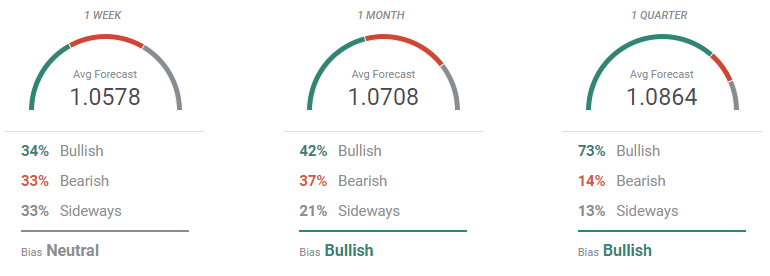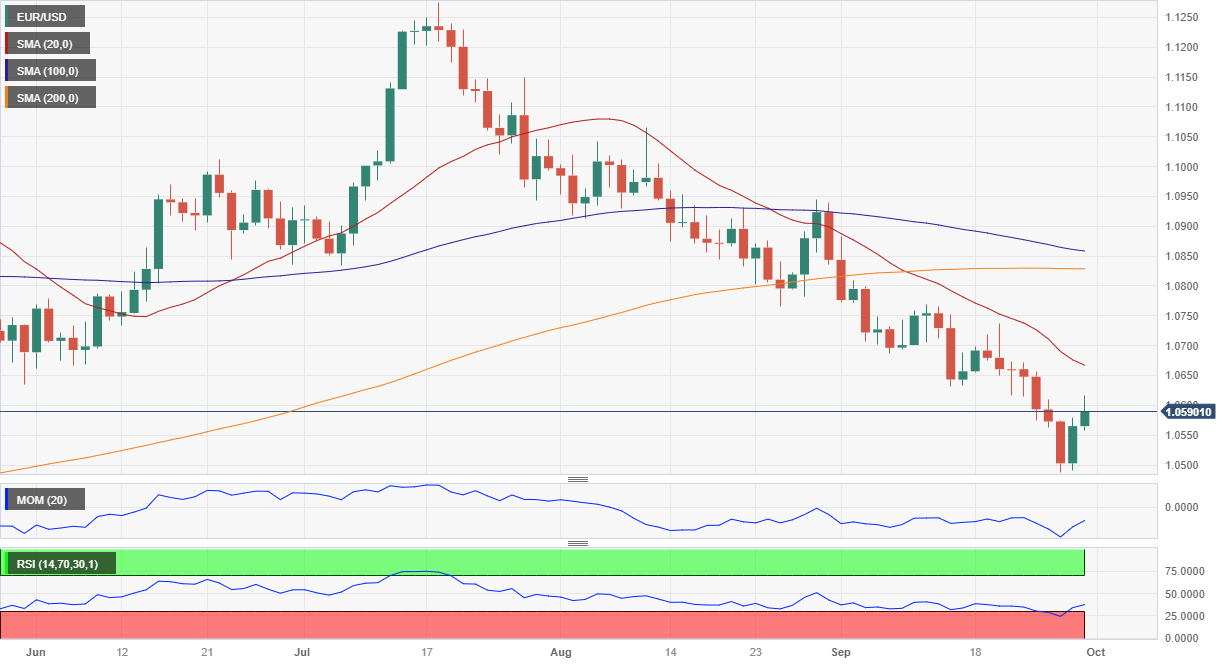- Inflation in the United States and the Euro Zone was not as hot as anticipated, relief returned to financial markets.
- United States ADP survey and Nonfarm Payrolls report in the docket next week.
- EUR/USD corrective advance could become more relevant if the pair advances beyond 1.0700.
The EUR/USD plummeted to 1.0487 on Wednesday, its lowest since early March, as investors continued to seek refuge in the US Dollar. Financial markets were in risk-averse mode following central banks’ monetary policy decisions from earlier this month, as despite holding fire, most policymakers reaffirmed the inflation risks remain high and rates should stay higher for longer to maintain price pressures under control.
The absence of relevant news throughout the first half of the week maintained the USD on the bullish side, but extreme overbought conditions and better-than-anticipated inflation-related figures put near-term pressure on the Greenback.
Not-so-hot inflation
Germany published the preliminary estimates of the September Harmonized Index of Consumer Prices (HICP) on Thursday, which resulted up by 4.3% YoY, below the 4.5% anticipated by market participants, and much better than the 6.4% posted in August. The Euro Zone HICP in the same period was also lower than anticipated. The European Central Bank's (ECB) preferred gauge of inflation rose by 4.3% YoY in September, down from 5.2% in August, while the core annual HICP rate printed at 4.5% against the 4.8% expected and below the previous 5.2%.
Across the pond, the United States (US) released the August Personal Consumption Expenditures (PCE) Price Index on Friday, the Federal Reserve's (Fed) favorite inflation reading. According to the US Bureau of Economic Analysis (BEA), the annual core PCE price index rose by 3.9%, down from the July rate of 4.3%, while the monthly increase printed a modest 0.1%.
Speculative interest was concerned overheating price pressures could lead to more aggressive central banks’ actions in the near future, which, in turn, fuels the odds of a steep economic setback.
Softer-than-anticipated inflation-related figures point in the opposite direction. Central banks could maintain the wait-and-see stance recently adopted while holding one more rate hike in reserve but hoping not to use it.
The macroeconomic calendar will offer some interesting figures next week, starting with the September US ISM Manufacturing PMI. S&P Global will also release the September Manufacturing PMIs for the EU and the US. Later in the week, S&P Global will publish the Services and Composite PMIs for both economies, while the US will unveil the official ISM Services index.
Additionally, the EU will publish August Retail Sales and the Producer Price Index (PPI) for the same month. Across the pond, the focus will shift to employment, as the US will publish the September ADP survey on private job creation ahead of the Nonfarm Payrolls (NFP) report for the same month. The latter is expected to show the country added 150K new positions in September, while the Unemployment rate is foreseen easing to 3.7% from 3.8% in August.

EUR/USD technical outlook
The better market mood weighed on the American currency ahead of the weekly close, although EUR/USD closed in the red for the eleventh straight week. The pair trades around 1.0580 despite the renewed optimism, as the US economic resilience skews the scale in the USD favor.
From a technical point of view, the weekly chart suggests additional declines are likely, as EUR/USD remains below bearish moving averages, with the 100 Simple Moving Average (SMA) providing dynamic resistance at around 1.0720. Technical indicators, in the meantime, keep heading south below their midlines, with the Relative Strength Index (RSI) indicator currently at 37.
The daily chart shows bears retain control, with the ongoing advance understood as a mere correction. The 20 SMA offers a sharply bearish downward slope far below the longer moving averages and provides dynamic resistance at 1.0665. At the same time, the Momentum indicator resumed its decline within negative levels, although it remains stuck within familiar levels. Finally, the RSI corrected extreme oversold conditions but lost upward strength and currently consolidates at around 35.
The 1.0480/90 region provides support ahead of the 1.0400 threshold. Once below the latter, EUR/USD would be en route to test 1.0340, a strong static support area. Sellers, on the other hand, are initially aligned around 1.0620 and 1.0700. Gains beyond the latter seem unlikely, yet a corrective impulse could see the pair trading as high as 1.0840 before it resumes its bearish trend.
EUR/USD sentiment poll
The FXStreet Forecast Poll suggests EUR/USD could soon confirm an interim bottom. The pair is seen neutral in the near term but bullish in the monthly and quarterly perspectives. On average, the pair is seen around 1.0700 in one month, extending the recovery to the 1.0860 region in the three-month view.
The Overview chart, however, indicates bears are likely to retain control. The three moving averages under study head firmly lower, standing at fresh multi-month lows. Furthermore, lower lows are now likely in the monthly and quarterly views, with increased odds for a break below 1.0400. At the same time, the number of those looking for levels at 1.10 or above decreased sharply, with a new ceiling in the 1.0900/1.1000 price zone.

Information on these pages contains forward-looking statements that involve risks and uncertainties. Markets and instruments profiled on this page are for informational purposes only and should not in any way come across as a recommendation to buy or sell in these assets. You should do your own thorough research before making any investment decisions. FXStreet does not in any way guarantee that this information is free from mistakes, errors, or material misstatements. It also does not guarantee that this information is of a timely nature. Investing in Open Markets involves a great deal of risk, including the loss of all or a portion of your investment, as well as emotional distress. All risks, losses and costs associated with investing, including total loss of principal, are your responsibility. The views and opinions expressed in this article are those of the authors and do not necessarily reflect the official policy or position of FXStreet nor its advertisers. The author will not be held responsible for information that is found at the end of links posted on this page.
If not otherwise explicitly mentioned in the body of the article, at the time of writing, the author has no position in any stock mentioned in this article and no business relationship with any company mentioned. The author has not received compensation for writing this article, other than from FXStreet.
FXStreet and the author do not provide personalized recommendations. The author makes no representations as to the accuracy, completeness, or suitability of this information. FXStreet and the author will not be liable for any errors, omissions or any losses, injuries or damages arising from this information and its display or use. Errors and omissions excepted.
The author and FXStreet are not registered investment advisors and nothing in this article is intended to be investment advice.
Recommended Content
Editors’ Picks

EUR/USD rose to fresh highs around 1.1240
EUR/USD maintained its bullish momentum on Thursday, climbing to the 1.1240 region as the US Dollar accelerated its decline amid growing concerns about the economic fallout from Trump's tariffs.

GBP/USD picks up pace, challenges 1.3000
GBP/USD made significant gains, edging just pips shy of the psychological 1.3000 barrier. The advance came amid trade war jitters and a sharp sell-off in the Greenback following the announcement of 145% US tariffs on China.

Gold flirts with record peaks near $3,175, Dollar tumbles
Gold continued its record-setting rally on fresh tariff-related headlines, surging past the $3,170 mark per troy ounce after the White House confirmed new tariffs, sparking another round of US Dollar selling.

Cardano stabilizes near $0.62 after Trump’s 90-day tariff pause-led surge
Cardano stabilizes around $0.62 on Thursday after a sharp recovery the previous day, triggered by US Donald Trump’s decision to pause tariffs for 90 days except for China and other countries that had retaliated against the reciprocal tariffs announced on April 2.

Trump’s tariff pause sparks rally – What comes next?
Markets staged a dramatic reversal Wednesday, led by a 12% surge in the Nasdaq and strong gains across major indices, following President Trump’s unexpected decision to pause tariff escalation for non-retaliating trade partners.

The Best brokers to trade EUR/USD
SPONSORED Discover the top brokers for trading EUR/USD in 2025. Our list features brokers with competitive spreads, fast execution, and powerful platforms. Whether you're a beginner or an expert, find the right partner to navigate the dynamic Forex market.
